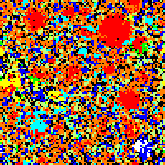Why Does Cement Set?
 Concrete has been known for literally thousands of years. It is a testament to the enduring strength of this material that concrete structures from those long-ago times are still standing strong today. What is going on inside concrete that makes this so? The answer is crystallization. When mixed with water, the molecular structure of the cement powder actually changes. Once all of the components are thoroughly mixed, and a more-or-less homogeneous mixture is obtained, the wetted components begin to recrystallize. But they don't just form the same things that they were before. What makes this work is that the components recrystallize as hydrated compounds. Each molecule of recrystallized and reformed material now incorporates a specific number of water molecules into the crystal. The water that was added to the mixture doesn't just evaporate or drain away; it actually becomes an integral part of the solid concrete.
Concrete has been known for literally thousands of years. It is a testament to the enduring strength of this material that concrete structures from those long-ago times are still standing strong today. What is going on inside concrete that makes this so? The answer is crystallization. When mixed with water, the molecular structure of the cement powder actually changes. Once all of the components are thoroughly mixed, and a more-or-less homogeneous mixture is obtained, the wetted components begin to recrystallize. But they don't just form the same things that they were before. What makes this work is that the components recrystallize as hydrated compounds. Each molecule of recrystallized and reformed material now incorporates a specific number of water molecules into the crystal. The water that was added to the mixture doesn't just evaporate or drain away; it actually becomes an integral part of the solid concrete.
As the wet mixture sets and hardens, billions of very small crystal blooms form throughout the mass and bind the whole thing together into a solid block. It is due to the physical interconnectedness of these crystal blooms and the other solid inclusions that concrete is so resistant to crushing, fracturing, stretching, and shearing. Once the wet mixture has solidified, it is not affected by water. Nor does water have much of an effect on the wet mixture once it has been put in place. A minor excess of water on the outside of the mass, such as occurs with standing water or when the surface is troweled smooth actually results in the formation of a smoother hard surface. The outside material separates from the larger aggregate particles and contains mostly recrystallized components and small aggregate particles. On solidification, these finer particles produce a smoother finished surface.
Too much water added to a mixture will prevent proper solidification; there is simply too much water to be included in the recrystallization process. Similarly, water that washes across the surface of the wet mixture carries away the dissolved components and prevents the mixture from solidifying. Mixtures for underwater applications - so-called 'hydraulic cement' - are blends designed to resist the intrusion of new water. It sets up quite quickly initially, which also keeps water out, and finishes setting in the normal way. Since air is not involved in the solidification process, it does not matter whether the concrete sets up to a solid block out of the water or completely under the water.
About the Author
Richard M J Renneboog, MS
 Richard M. J. Renneboog is an independent private technical consultant and writer in both chemical and computer applications. Endeavors have included preparation of scripts for instructional and promotional video, corporate website design, curriculum development for training in advanced composites technology, and development.
Richard M. J. Renneboog is an independent private technical consultant and writer in both chemical and computer applications. Endeavors have included preparation of scripts for instructional and promotional video, corporate website design, curriculum development for training in advanced composites technology, and development.


